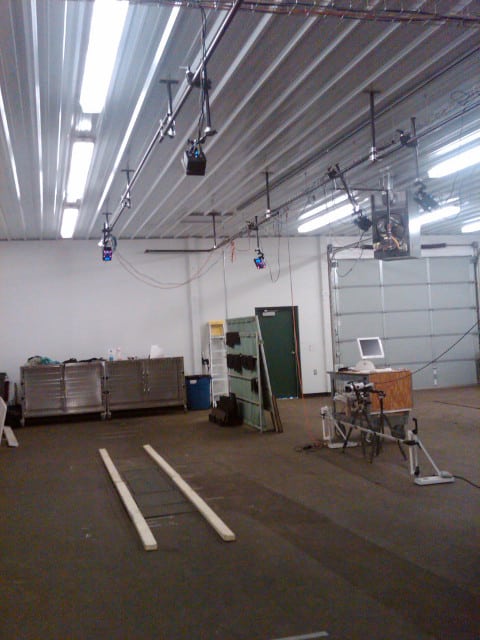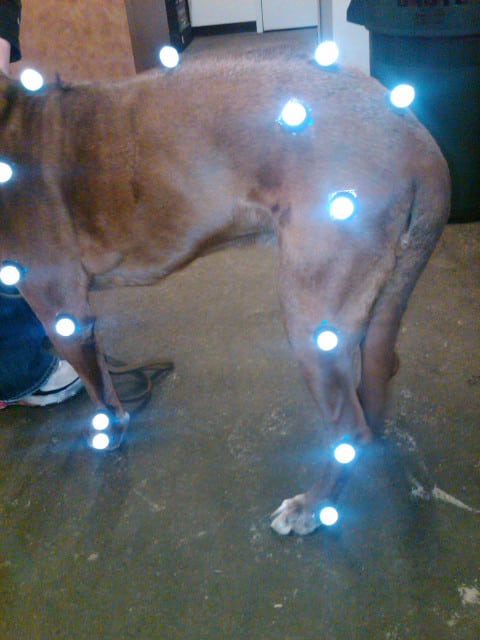Caring for a Three Legged Dog or Cat
Tripawds is your home to learn how to care for a three legged dog or cat, with answers about dog leg amputation, and cat amputation recovery from many years of member experiences.
Join The Tripawds Community
Learn how to help three legged dogs and cats in the forums below. Browse and search as a guest or register for free and get full member benefits:
Instant post approval.
Private messages to members.
Subscribe to favorite topics.
Live Chat and much more!
The "Tripawd hop" is an endearing trait that we're all familiar with, but it doesn't come without repercussions on an animal's body.
[youtube][/youtube]
Two recent canine amputee gait studies by Colorado State University took a closer look at the biomechanical changes that occur in amputee dogs, in order to help further research that will develop alternative limb-preserving procedures for dogs:
"Kinematic and kinetic analysis of dogs during trotting after amputation of a thoracic limb"
and
"Kinematic and kinetic analysis of dogs during trotting after amputation of a pelvic limb"
We asked one of the study's leaders, assistant professor of surgical oncology Dr. Deanna R. Worley, DVM,to tell us a bit more about these two fascinating studies. Here's our email conversation:
Dr. Worley, why did your team study the gait of dogs who've lost a limb?

Trotting gait was used because it had not previously been evaluated in amputee dogs. In the clinics when I have the pleasure of examining and treating our amputee patients, they typically move so quickly...it is rare to see one strolling in at a leisurely walk. I smile as I frequently find myself being pulled down the hallway by exuberant amputee dogs!
From a scientific perspective, using a faster trotting gait for analysis, there was thought that there would be more force exerted on each leg than at a walk and possible periods where the dog would be supported by one limb. We found in thoracic limb amputee dogs, they adopt their own unique gait pattern to move which is a blend of a walk, trot and gallop. This pattern is not seen in quadruped dogs.
The study found that the remaining thoracic and pelvic limbs in forelimb amputees take on more braking force when trotting. What does this mean for the long-term physical health of these dogs? Are there things we can do to minimize the impact on the other limbs?
The most important things to do to minimize impact on other limbs is keeping your dog in as good as health as you can, particularly maintaining a healthy weight, and creating a home environment that is not difficult for your dog to navigate. This includes non slip flooring, comfortable stair steps (no extreme rise and run of constructed stairs), moderate level of physical activity, and ongoing therapy for any concurrent osteoarthritis.


Were dogs of all sizes enrolled in the studies? If so did you notice a difference in the gait analysis results of larger dogs versus smaller dogs?
Dogs needed to be greater than 30 pounds body weight for inclusion to the study. The practical reason was because the pressure plates the dogs walked over couldn't easily be adjusted/shortened for smaller dogs with short strides. Clinically we have not observed any difference in amputation outcomes between giant and large breed dogs versus smaller and medium breed dogs. We were criticized during the review process of our articles for performing amputations in larger dogs, even though the published body of knowledge does not support the opinion that larger dogs adapt less well to a limb amputation.
I'm curious about this comment in the Thoracic Limb Gait Study: "Although not evident in the present study, it is possible that complete adaptation to limb amputation may require longer than 1 month and that additional gait alterations ad compensatory strategies may place these dogs at increased risk for musculoskeletal injury in one of the remaining limbs." I know your answer would mostly be a guess, but in your expert opinion, what types of things can pet parents do (or avoid) to help our dogs make that transition to three legs without risk of injury? Would the risk of injury be the same for front and rear limb amputees?
What I've observed in recent years is the transition in amputee dogs from a four-legged state to a three-legged state can be improved and shortened with incorporation of physical therapy performed by trained veterinary physical therapists. There is some thought that with the same amount of activity being born by joints in three legs instead of four, that there is increased wear and use of those remaining joints which can theoretically increase risk and or progression of osteoarthritis.


Do you have any plans for future studies about three-legged dogs? How can we as a community support/donate to work like this to ensure the long term health of future canine amputees?
The goal of the present studies was to provide a thorough description of the biomechanical changes that occur in amputee dogs and to use that as a comparison for further research exploring alternative limb-preserving procedures.
[youtube][/youtube]
Let's all give a round of 3-paws up to Dr. Worley and the team at CSU for helping to make life better for three-legged animals and their humans!
Tripawds Founders Jim and Rene
tripawds.com | tripawds.org | bemoredog.net | triday.pet
YAAAAAAAAAY FOR HELPING TRIPAWDS!!!
Okay, was able to see Ziggy video on home page, but not able to see the two videos you plsted above.....anybody else with a tablet have the same issue?
I thought it was interesting that the study was "critized" for using large dogs.....sure, maybe they take a bit longer to recover, but the nay sayers need ro check out Size and Age section on here!!!
Also interesting that...if I read it right...one m i nth is the average recovery time for adjustment, etc. That will certai n ly be reassuring to those who lanic if recovery hasnw taken place within two weeks (like I did!).
Thanks, yet again, for the info!!
Sally and Alumni Happy Hannah and Merry Myrtle too!
Happy Hannah had a glorious additional bonus time of over one yr & two months after amp for osteo! She made me laugh everyday! Joined April's Angels after send off meal of steak, ice cream, M&Ms & deer poop!
Hey Sally,
Weird that the videos didn't post here but in the Blog they did.
I agree, our Size and Age Matters Forum is especially pawesome and inspawrational!
As for the average recovery/adjustment time, I think that perhaps we as a community, vets included, need to be more specific on what constitutes "recovery" versus "adjustment" when we talk about that two weeks. Big difference between stitches out (recovery) and getting around in the backyard, playing, etc (adjustment). Thanks for pointing that out.
Tripawds Founders Jim and Rene
tripawds.com | tripawds.org | bemoredog.net | triday.pet
This is a great study. Thank you for posting. I know they were criticized for only working with dogs over 30lbs, but it's exploratory. I'm sure this will open more doors to this type of examinations. I can't imagine that putting a lot of pressure on the single leg would not have some repercussions. I give Carly doggies massages sometimes and she's on joint support, but it would be great to have some empirical insights into different methods we can use to help our best buddies!
1 Guest(s)

 Register
Register Log In
Log In Members
Members

 Read the original blog post
Read the original blog post Add Reply
Add Reply Add Topic
Add Topic Offline
Offline













